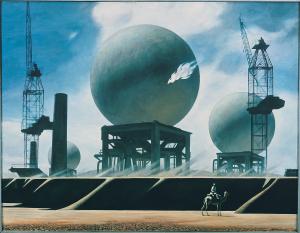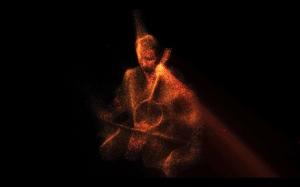The Kazakhastan Pavilion at Venice Biennale 2024 is an exhibition that draws on the nation’s ancient history as an artistic inspiration to envision the future.
VENEZIA, VE, ITALY, October 23, 2024 /EINPresswire.com/ — Kazakhstan returns to the Venice Biennale for its second appearance with the exhibition “Jerūiyq: Journey Beyond the Horizon,” staged at the historical building of the Naval Museum. The exhibition, open until the end of November, is inspired by national legends and the mystical 15th-century figure Asan Kaigy, “Kaigy” is a very particular word translated from Kazakh as “pain” that reflects traumatic encounters with the deep dark side of our modern society.
Commissioned by Aida Balayeva, Minister of Culture and Information, and brillantly curated by Danagul Tolepbay with the co-curator Anvar Musrepov, here also in the guise of artist, the exhibition reflects Kazakhstan’s commitment to cultural heritage and artistic innovation, developing the main theme of the Biennale 2024 “Foreigners Everywhere – Foreigners Everywhere”.
The involved artists shows their vision of ideal worlds inspired by spirits and mystical rituals. Jerūiyq: Journey Beyond the Horizon presents a visionary future based on a convergence between human and nonhuman.
In the Kazakhstan Pavilion visitors can see a selection of artworks inspired by the Country’s culture, history and contemporaneity. The exhibition offers a very special perspective embracing past, present and future with a focus on the creative processes and conceptual practices, particularly those that emerged in the 1960s and 1970s.
The project stands out for its multidimensional approach, highlighting the real essence of Kazakhstan, investigating the most relevant political transformations during the 20th century, starting from the Resistance that involved many Kazakh artists, in contrast to the Soviet dominance perceived as alien to the local culture. In this framework another significant and vibrant theme is the progressive dispersion of the human race.
The curatorial project is divided in three distinct sections The first section of the exhibition presents two works realized by Yerbolat Tolepbay, a key figure in contemporary Kazakh art, based on the tension between hope and destruction in an apocalyptic context. In the same room we find the project “Presence ” by Eldar Tagi and Lena Pozdnyakova, an artistic duo, the2vvo, the dynamic performance between nature and culture in the Anthropocene era has been tackled, focusing on the revaluation of traditions in the context of the environmental crisis.In this way, we can identify the key aspects of contemporary artistic conception, examining the notion of repetitiveness and the extent to which it is integrated into our perceptual environment. Duet singing, a method associated with local rituals and communication with nature and the supernatural, serves as a “sonic hologram” that reflects the interconnectedness between humans and the environment, challenging anthropocentric perspectives.
In the next section, the artists Sergey Maslov and Saken Narynov explore the connection between humanity and cosmos. Sergey Maslov, pushes the limits of visual perception by blending the traditional Kazakh yurt with imagery of spaceships and extraterrestrials while Narynov proposes an experimental and transformative building, a modular system designed for human habitation on other planets.
In the final part of the exhibition Kamil Mullashev, the Chinese Symbolist father, his paintings depict futuristic scenes and are placed in dialogue with the artwork of Anvar Musrepov “Alastau” that means purification, the video is connected to one of the oldest pagan rituals tied to Tengrism—a spiritual tradition that thrived in the Kazakh steppes before the rise of Islam. This speculative video essay takes its viewers to a distant future where the Sun has vanished. In this apocalyptic setting, the remaining tribes have reverted to nomadic lifestyles and ancient rituals, evading entities whose presence signals the end of all life.
In a globalized era, Jerūiyq: Journey Beyond the Horizon, offers an amazing vision of the capacity of Kazakh artists to mix tradition and innovation, creating a unique and contemporary synthesis of their cultural heritage.
Discovering artists
Kamil Mulashev, born in 1944 in Urumqi, China, is a versatile artist with a global presence. After studying in Urumqi and the Surikov Institute of Art in Moscow, he now lives and works in Astana, Kazakhstan.
Yerbolat Tolepbay, born in 1955, a key figure in Kazakhstani fine arts, lives and works in Almaty, Kazakhstan. Internationally celebrated, his masterful works are deeply connected to Kazakh heritage and have earned him the Order of the French Chevalier for Arts and Literature.
Saken Narynov (Esik, 1946- Almaty, 2023) lived and worked in Almaty, Kazakhstan, combining architectural and sculptural skills with his passion for science and philosophy. His innovative works continue to inspire.
Sergey Maslov (1952-2002), a central figure in Kazakhstan’s contemporary art scene, lived in Almaty. His unconventional methods and myth-soaked art have left a deep mark.
The2vvo, with Eldar Tagi, (b. 1987) and Lena Pozdnyakova (b. 1985), originally from Almaty, now a nomadic art duo based in Berlin. Their work integrates sound, visual arts and performance.
Anvar Musrepov, born 1994, an artist and curator based in Astana, works in new media, focusing on the future and identity. His contributions have significantly shaped new media art in the local contemporary art environment.
Cristina Gatti
Cristina Gatti Press & P.R.
[email protected]
Legal Disclaimer:
EIN Presswire provides this news content “as is” without warranty of any kind. We do not accept any responsibility or liability
for the accuracy, content, images, videos, licenses, completeness, legality, or reliability of the information contained in this
article. If you have any complaints or copyright issues related to this article, kindly contact the author above.
![]()
Originally published at https://www.einpresswire.com/article/754199253/venice-biennale-2024-meets-kazakhstan-a-magic-pavillion-between-classicism-and-contemporary-vibrations




